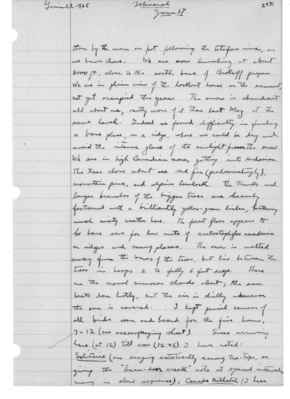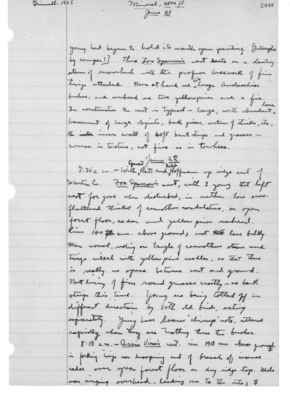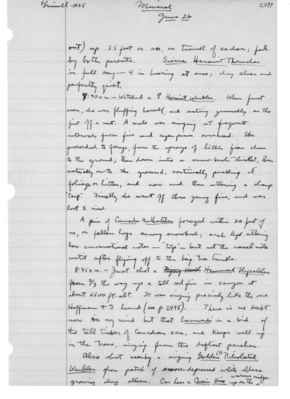Pages That Mention ridge
1925: Joseph Grinnell's field notes
S2 Page 15
Collector: Grinnell - 1925 Location: Lassen Section (Mineral) Date: June 17, 1925 Page Number: 2471
then by the man on foot following the telephone wire, as we have done. We are now leveling at about 8000 ft., close to the south base of Brokeoff proper. We are in plain view of the lookout house on the summit, not yet occupied this year. The snow is abundant all about us, vastly more of it than last May at the same level. Indeed we found difficulty in finding a bare place, or a ridge, where we could be dry and avoid the intense glare of the sunlight from the snow. We are in high Canadian zone, getting into Hudsonian. The trees close about are red fir (predominantly), mountain pine, and alpine hemlock. The trunks and larger branches of the bigger trees are heavily festooned with a brilliantly yellow-green lichen, betokening much misty weather here. The forest floor appears to be bare save for low mats of arctostaphylos nevadensis on ridges and sunny places. The snow is melted away from the bases of the trees, but lies between the trees in heaps 2 to fully 6 feet deep. There are the usual summer clouds about; the sun beats down hotly, but the air is chilly whenever the sun is covered. I kept pencil census of all birds seen and heard for the five hours, 7-12 (see accompanying sheet). Some arriving here (at 12) till now (12:45) I have noted: Solitaire (one singing extatically among tree-tops, or giving the "barn-door creak" note at spaced intervals, many in slow sequence); Canada Nuthatch (I hear
S2 Page 19
Collector: Grinnell - 1925 Location: Lassen Section (Brokeoff Mt.) Date: June 17, 1925 Page Number: 2474
Then down over "bald" hills and ridges to here, where the Timber begins again. This "baldness" of the mountains of middle altitude in this section of the Sierras is due to their dense and continuous clothure of chaparral. This makes them look at a distance as tho they were covered with green grass. The chaparral here (6000-6500) consists of the big shiny-leafed ceanothus velutinus, the thorny ceanothus condulatus, arctostaphylos patula (pure growths in places), the dwarfed arctostaphylos nevadensis here at its lowest limit and growing up to two feet high, and tracts of red cherry. 4:15 p.m. - At about 6700 ft.; at least there, maybe a family, of Blue-fronted Jays, which species I didn't check on the way up; as also a pair of solicitous Red-breasted Sapsuckers. This is near the bottom of a timbered ravine. A red fir is abundantly punctured from about 4 to 12 feet up, and bleeding - probably the work of this sapsucker. 4:30 p.m. - Just had a "great kick": within 50 feet in front of us there suddenly appeared a female Sierra Grouse and simultaneously she whistled again and again, a rather piercing squall, almost; then she began to intersperse these startling (terrifying?) notes with clucks - kirk, kirk, kirk, 6 to 10 in succession. When we ran up, she flew up 80 feet or so into a red fir, now clucking at quarter-minute intervals. Almost at the instant the hen
S2 Page 33
Collector: Grinnell-1925 Location: Mineral, 4800 ft. Date: June 21 Page Number: 2488
young had begun to hold its mouth open pouting. [Interrupted by camper!] This Fox Sparrow's nest rests on a slanting stem of snow-bush with the proper lacework of fine twigs attached. Near at hand are two large Amelanchier bushes; and overhead are two yellow pines and a fir. In construction the nest is typical - large, with abundant loose basement of large objects, bark pieces, section of sticks, etc., the inner wall of soft bark strips and grasses course in texture, not fine as in towhees.
June 22 7:34 a.m. - With ^Egmont Rett and ^Ralph Hoffmann up ridge east of Martin Cr. Fox Sparrow's nest, with 3 young that left nest for good when disturbed, in rather low snow flattened thicket of ceanothus cordulatus, on open forest floor, cedar and yellow pines overhead. Rim 140 ft mm. above ground; nest last less bulky than usual, resting on tangle of ceanothus stems and twigs mixed with yellow pine needles, so that there is really no open space between nest and ground. Nest lining of fine round grasses mostly - no bark strips this time. Young are being lolled (?) off in different direction by both old birds, acting separately. Young have hoarse "chirrup" note, uttered rapidly when they are trotting thru the bushes.
8:15 a.m. - Cassin Vireo's nest: rim 1910 mm. above ground in forking twigs near drooping end of branch of incense cedar over open forest floor on dry ridge top. Male was singing overhead, leading me to the site; [female symbol]
S2 Page 36
Collector: Grinnell - 1925 Location: Mineral Date: June 22 Page Number: 2490
sheltered within the cavity, the nest being in-set in bark and needle floor right against the charcoal wall. Rim of nest (exposed side) marked by coarse pine twigs and needles, scattering out towards opening of cavity; latter 600 mm. high at peak, 480 mm. wide at base of opening; rim of nest a little higher, about 25 mm., than ground in front. Nest found by watching old birds, with food perching around quietly on stubs of fallen logs and lower branches of big standing trees, finally flying down to side. The yellow thickened corners of mouth and edges of bill loom up a most conspicuous feature of young in shade of cavity. On dry ridge top, open forest of white fir, cedar, yellow and sugar pines.
Saw a Sharp-shinned Hawk in flight from direction of camp, well above tree-tops. One or both of a pair of Evening Grosbeaks were noted repeatedly in a certain section of the woods. Mr. Hoffmann discovered a Hammond(*) Flycatcher's nest^(5500 ft. alt.) fully 90 ft. up on a horizontal sub-branch of a huge sugar pine - of course inaccessible. The birds looked ^at that range and sounded, to me, indistinguishable from the "Wright" Flycatchers I have been getting down here with low brush-built nests. However, only shooting of the birds can settle their identity. I saw one of Hoffman's birds come clear to the ground and flit about in small firs and low snow-brush; yet both of the birds did a lot of foraging fully 100 feet up, in firs and pines.
S2 Page 43
Collector: Grinnell - 1925 Location: Mineral Date: June 26 Page Number: 2497
out) up 35 feet or so, on trunk of cedar; fed by both parents. Sierra Hermit Thrushes in full song - 4 in hearing at once, day clear and perfectly quiet.
7:40 a.m. - Watched a [female symbol] Hermit Warbler. When first seen, she was fluffing herself, and attacking generally as tho just off a nest. A male was singing at frequent intervals from fir and sugar pines overhead. She proceeded to forage, from the sprays of little fir close to the ground; then down into a snow-bush thicket, then actually on to the ground, continually picking at foliage or litter, and now and then uttering a sharp "tsip." Finally she went off thru young firs, and was lost to view.
A pair of Canada Nuthatches foraged within 20 feet of us, on fallen logs among snowbush; each kept uttering low conversational notes "Tiys" - but not the nasal note until after flying off to the big tree trunks.
8:45 a.m. - Just shot a Pygmy Nuth Hammond Flycatcher from 2/3 the way up a all red fir in canyon at about 6500 ft. alt. It was singing precisely like the one Hoffmann & I heard (see p. 2495). There is no doubt now in my mind but that hammondi is a bird of the tall timber of Canadian zone, and keeps well up in trees, singing from the loftiest perches.
Also shot a singing Golden ^(?) Pileolated Warbler from batch of snow-depressed white alders growing along the stream. Can hear a Cassin Vireo up on the ^warmer ridge.




